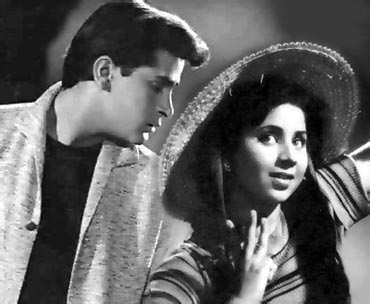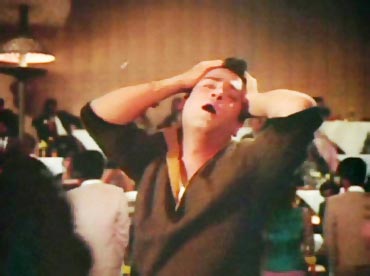 | « Back to article | Print this article |
Rashmi Bansal: Be a career junglee
In her previous column for Rediff.com, Rashmi Bansal, the author of bestsellers Stay Hungry Stay Foolish, Connect the Dots and most recenly I Have a Dream, questioned the vision behind producing MBAs in tier-3 B-schools in tier-2 towns.
Here, she talks about career lessons for India's youth from the life and times of 'yahoo' actor Shammi Kapoor.
Shammi Kapoor died in his sleep on August 14, 2011, 4.30 am IST, at the age of 79. More than 40 years after he last played out his junglee days. The light hearted romantic hero of numerous hit films.
Yet, there was an outpouring of grief on social network sites. As his mortal remains were taken for cremation, the streets were lined with ordinary people, Kolis (fishermen) played the song 'Yahoo!' in one last, boisterous, celebratory farewell.
All this, because Shammi Kapoor was a symbol of life, of zest, of joy.
Imagine any other person, say a businessman, who ran a very successful company for say, 10 years. And then, failed and shut shop. Which is kind of what happened to the jovial Shamsher Raj Kapoor.
By 1970, he was edged out by Rajesh Khanna, the new, chikna (handsome) romantic hero. But more than that, it was Shammi's own (lost) battle with weight which proved to be his downfall.
He did try directing films. But unlike brother Raj Kapoor, he did not succeed in that arena. The hero now played supporting actor roles, and over time pretty much retired from the public eye.
And yet, like I said, he left such an imprint in the minds and hearts of generations of Indians. That 40 years later, we woke up and cried to hear he was gone.
I think that is so beautiful and rare, and something we all should take note of.
Are we bringing joy to the lives of the people we touch everyday?
Because that is all that really matters.
Are we being original and true to ourselves?
Because that is all that is needed.
We can't all be actors, but we can learn from the life of Shammi Kapoor. The one and only way to be truly successful is to create your own brand. Like he did.
Rashmi Bansal, the author of the bestsellers Stay Hungry Stay Foolish, Connect the Dots and most recently I Have a Dream, writes on youth, careers and entrepreneurship. You can reach her at mail@rashmibansal.in
Creating the Cult
Shammi Kapoor entered the industry at age 17, as a junior artiste, at a salary of Rs 50 per month. He made his debut in Bollywood in the year 1953, in the film Jeevan Jyoti.
As the son of Prithviraj Kapoor and brother of Raj Kapoor, getting into the movies came easily. Getting into the hearts of the audience was quite another matter. Shammi was stuck in uninspiring roles, wearing silly wigs and melodramatic expressions.
What's worse, critics wrote him off as a copycat. Years later he recalled how a review of his second picture Rail ka Dibba said: 'Shammi Kapoor apes Raj Kapoor'.
"It hurt a lot because I didn't understand what it meant to ape somebody because I wasn't aping. I came from the same school of acting. We were from the same stage and had done the same roles. But it made me realise that it was going to be tough."
In 1955, Shammi married Geeta Bali, a popular star of that era.
"I was in even deeper trouble. Then I was no longer only the son of Prithviraj Kapoor, and brother of Raj Kapoor, but I was also the husband of Geeta Bali. That's three-to-one. It gave me a challenge, an incentive to go out there and prove myself."
Apparently, at one point, Shammi Kapoor even considered giving up films and finding a job as a manager on a tea plantation in Assam. It was Geeta Bali who persuaded him to stick it out.
The turning point came when Filmistan gave writer Nasir Hussain a break as director, with Tumsa Nahin Dekha; the problem was Dev Anand was not available, neither was Sunil Dutt.
Sashadhar Mukherjee, co-owner of Filmistan told Nasir Hussain, 'Try this lad. Let's see how it works out. I see some greatness in him.'
Shammi could never be sure what that greatness was, but the fact that 'someone' believed in him inspired him.
"I had nothing to lose, so I went all out, changed my image, shaved off my moustache, got myself a crew cut, and there grew the yahoo image."
The rest is history.
Why did it work?
Because it was different, and captured the imagination of people. Nasreen Munni Kabir is a film journalist who's written the chapter on Shammi for an upcoming book titled Bollywood's Top 20: Superstars of Indian Cinema. She notes:
"When Tumsa Nahin Dekha was released in 1957, cast opposite Ameeta, Shammi Kapoor impressed with his intuitive and fresh acting, playful edge and great physical agility, which involved jumping, leaping and general cavorting.
Most importantly, he exuded an unabashed and irresistible sexuality that was far from the prudish heroes of the time... With his dreamy eyes, soft voice, charming dialogue delivery and arresting personality, Shammi radiated the raw appeal of an Elvis Presley -- especially evident when performing the songs."
Success then, was a mix of destiny and design. Established heroes not being available, Nasir Hussain being a debut director open to new ideas -- these were the elements of destiny.
Design was the careful crafting of a new image. A more westernised, free-wheeling 'rebel' star. Of course this only worked because it was not 'put on'. Shammi was just being his natural, exuberant self.
A man who dances to the tune of his heart must create the steps to go along with it. And that, is literally what Shammi Kapoor did.
As he once said in an interview, "My dancing was entirely extempore. I never knew what my next step would be. Sometimes, if I had to give a second take, my steps would be different. I couldn't do the same thing again. I had, within me, a dormant, incredible energy that was screaming out for expression, and, luckily, my directors agreed to let me do what I wanted."
Tap your own dormant energy, express yourself fully and honestly.
It is bound to work.
Finding your own rhythm
Shammi Kapoor found 'success' after four years of struggle and 19 flops. That's how life treats most of us. The important thing is to retain hope. To build self-awareness. And seize your moment, when it presents itself (as it must!)
Working in a large company, you may have a chance to work on an exciting loosely defined new project. Take it!
Tired of bureaucracy and bossy management, you may have a chance to partner your college buddy in a start-up. Give it a shot!
Struggling for a break as a writer/ musician/ graphic artist, you decide to 'self publish' and market your own creation. Give it all you've got!
Nasir Hussain and Shammi Kapoor went on to make dozens of hit films together. The first success opens doors to fields of golden opportunity, beyond your wildest imagination. But the burden of creating that success rests solely on your shoulders.
On your judgement, your inner compass of intuition.
Beware!
Wellwishers will advise you ki aisa karo (this is what the market wants). The truth is, nobody knows what they want. The real needs of people are unspoken, unfelt. But when you tap into those needs, they embrace you with a fierce loyalty and enthusiasm.
Shammi slithered down the snow covered valleys of Kashmir with a light disdain of parental authority and conventional behaviour. He struck just the right chord.
Employ the same principle, and create the product or service, song or book, that everybody (secretly) wants. People will flock to you, like bees towards honey.
Create a revolution, your own Ramlila maidan.



